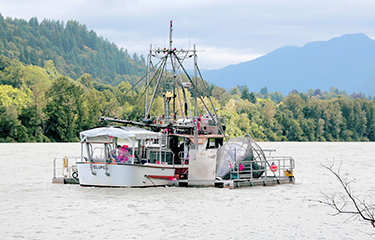BC salmon fishery on verge of commercial collapse

Low returns of wild salmon in the Canadian province of British Columbia over the summer have those involved in B.C.'s commercial fishery concerned about its future.
Wild salmon species failed to return in expected numbers in some rivers this year, most notably the Fraser River. And where there were reports of strong runs, a lack of commercial infrastructure limited the harvest.
According to the B.C. Salmon Marketing Council, wild salmon has contributed an average of 12.7 percent of the landed value of wild seafood in the province over the past decade, with a wholesale value ranging between CAD 150 million and CAD 250 million (USD 112 million and USD 186 million, EUR 108 million and 181 million) – the higher end of that range reported during years where dominant salmon runs were recorded.
But in recent years, a combination of the effects of climate change, recent extreme weather events, eroding infrastructure, and fishery management issues contributed to losing Marine Stewardship Council certification for key species. Together, those issues have stakeholders fearing the industry may have reached a breaking point.
Observers said the industry’s demise is most evident on the Fraser River, where a dominant year was expected for sockeye but never materialized, forcing a closure of its commercial fishery.
In September 2022, the Fraser River Panel of the Pacific Salmon Commission slashed its initial run estimate of 9.8 million sockeye by 30 percent for what has historically been Canada’s most-productive commercial wild salmon fishery. And a status report published by the commission in early October indicated a run of 6.8 million fish on the river.
This year’s poor run, in what was expected to be a dominant year where sockeye return to spawn in large numbers, has observers questioning the health of the entire Fraser River watershed.
On Vancouver Island, strong returns were reported on the Somass River and further north, 2022 has produced a bumper run on the Skeena River – estimated at nearly four million fish, twice the average for the last decade, according to The Tyee.
But even with the strong run on the Skeena – the nation’s second-largest salmon-producing region – a decline in processing capacity limited the industry’s ability to maximize returns.
Watershed Watch Consultant and Fisheries Advisor Greg Taylor said the number of vessels and processing infrastructure in the Skeena fishery have been disappearing and as a result, less than 50 percent of the commercial allocation will be caught there, leading to further erosion of the industry.
“Besides those sockeye fisheries in the North and the Somass, there is essentially no commercial fishing,” he said. “I think you can talk about the collapse of commercial fisheries, but I would shy away from using the term for salmon themselves. Salmon populations are low, but they’re still there.”
The decline of B.C.’s wild salmon fishery prompted the Canadian government to announce CAD 634 million (USD 473 million, EUR 460 million) in funding in 2021, as part of a five-year plan to restore wild Pacific salmon stocks.
The plan is expected to include habitat restoration and new hatcheries, and work recently began on a new hatchery on the Coquitlam River, which feeds into the Fraser.
But Taylor said there is little to show for thus far in implementation of the plan.
“There’s very little benefit from that CAD 634 million, except from reshuffling the bureaucracy,” he said. “They haven’t identified priority stocks, and they’re not going to until March 2023. It will be over two and a half years in, without anything on the ground happening.”
For many, what makes the fishery’s decline even more difficult to accept is seeing the relative consistent abundance reported in other rivers systems in the Pacific Northwest, most notably in Alaska’s Bristol Bay.
Preliminary data from the Alaska Department of Fish and Game (ADFG) recorded a run of 79 million sockeye there in 2022, surpassing the previous record of 44.3 million set in 1995.
Observers say the large salmon runs further north may be benefiting from the effects of climate change, including cooler water temperatures.
A changing climate and extreme weather events, such as the prolonged drought that produced the warmest and driest September on record in B.C. this September, will only add to challenges for the industry, Canadian Pacific Sustainable Fisheries Society (CPSFS) Secretary-Treasurer Christina Burridge said.
“It’s not that long ago that we could see ourselves as having enormous opportunities in salmon, and what we found instead is the combination of challenges in management policy and variation in climate and environmental factors, both on the water and freshwater habitats,” she said. “This has created challenges for the fish and for those who depend on them.”
As a result of the combined challenges, the infrastructure needed for a successful fishery has begun to disappear – causing knock-on effects hastening the industry’s demise.
“We have seen a decline in fishing infrastructure, in processing activity, in the ability of vessels to get to the right place at the right time,” Burridge said. “It will be a challenging picture for salmon and commercial salmon fisheries going forward.”
Photo courtesy of Eric Buermeyer/Shutterstock






Share